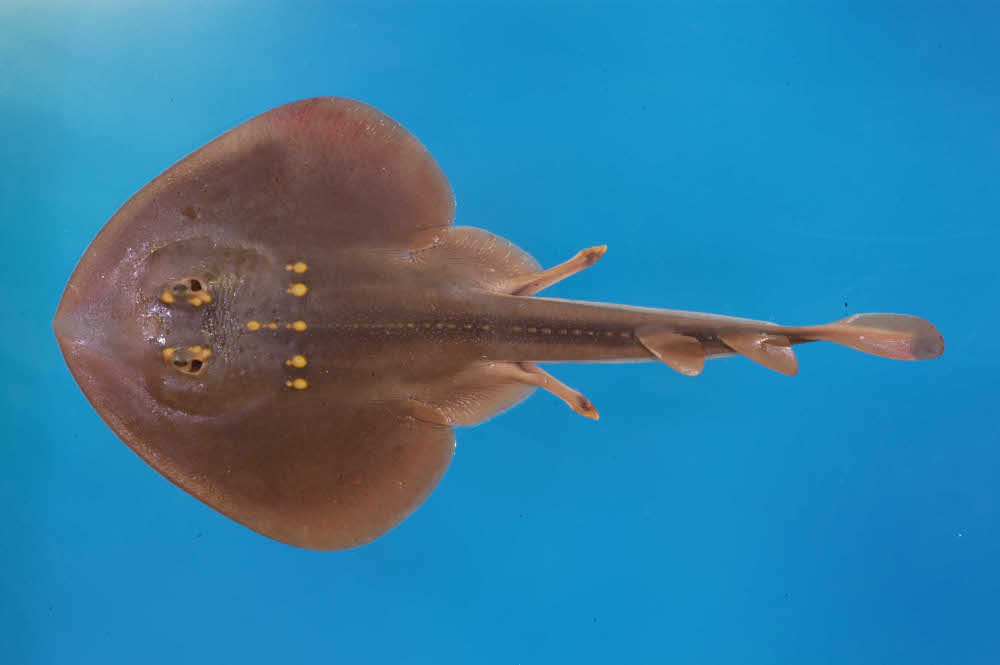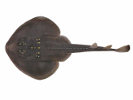Platyrhina tangi
Iwatsuki, Zhang & Nakaya, 2011
Yellow-spotted fanray
Classification: Elasmobranchii Rhinopristiformes Platyrhinidae
Reference of the original description
A review of the genus Platyrhina (Chondrichthys: Platyrhinidae) from the northwestern Pacific, with descriptions of two new species. Zootaxa, 2738, 26–40
A review of the genus Platyrhina (Chondrichthys: Platyrhinidae) from the northwestern Pacific, with descriptions of two new species. Zootaxa, 2738, 26–40
Image of the original description
Image in copyright.
Image in copyright.
Types
Platyrhina tangi
Holotype: MUFS: 23163; Paratype: FFNU: P-00005; FFNU: P-00006; FFNU: P-00007; FFNU: P-00008; FFNU: P-00009; FFNU: P-00010; KPM-NI: 2488; KPM-NI: 3205; KPM-NI: 3616; MUFS: 23565; MUFS: 23727; MUFS: 23717; MUFS: 23718;
Platyrhina tangi
Holotype: MUFS: 23163; Paratype: FFNU: P-00005; FFNU: P-00006; FFNU: P-00007; FFNU: P-00008; FFNU: P-00009; FFNU: P-00010; KPM-NI: 2488; KPM-NI: 3205; KPM-NI: 3616; MUFS: 23565; MUFS: 23727; MUFS: 23717; MUFS: 23718;
Description :
Citation: Platyrhina tangi Iwatsuki, Zhang & Nakaya, 2011: In: Database of modern sharks, rays and chimaeras, www.shark-references.com, World Wide Web electronic publication, Version 01/2026
Please send your images of "Platyrhina tangi" to info@shark-references.com

Platyrhina tangi Iwatsuki, Zhang & Nakaya, 2011: MUFS 23163; holotype, 39.8 TL, male , Japan, Meitsu, Miyazaki © Iwatsuki, Yukio, Department of Marine Biology & Environmental Sciences, Miyazaki, Japan

Platyrhina tangi Iwatsuki, Zhang & Nakaya, 2011: MUFS 23163; holotype, 39.8 TL, male , Japan, Meitsu, Miyazaki © Iwatsuki, Yukio, Department of Marine Biology & Environmental Sciences, Miyazaki, Japan
Common names
Yellow-spotted fanray
Yellow-spotted fanray
Short Description
This species is distinguished from its congeners in having the following set of characters: a row of thorns (weakly hooked, sometimes tubercle-like) on mid-dorsum of tail; no thorns on the anterior part of scapular region; thorns on the orbital, nape and scapular regions encircled by light yellow or white pigment; dorsal surface covered with minute and some clearly larger dermal denticles (coarse to touch) (Ref. 86259). Diet: Ariake Bay, Japan (data base: 334 specimens, 175 males and 192 females): Thirty-seven prey items were identified at the species level, including 5 shrimp species, 1 stomatopoda species, 1 leptocardia species, 4 fish species, and 1 cephalopoda species. Crustaceans were the most common prey. Above all, the small shrimp Leptochela gracilis was the most important prey item in terms of Percentage weight (24,67 %W) and frequency of occurrence (55.25 %F). There was no significant interaction of sex and size with %W for the 3 categories of prey [13831];
This species is distinguished from its congeners in having the following set of characters: a row of thorns (weakly hooked, sometimes tubercle-like) on mid-dorsum of tail; no thorns on the anterior part of scapular region; thorns on the orbital, nape and scapular regions encircled by light yellow or white pigment; dorsal surface covered with minute and some clearly larger dermal denticles (coarse to touch) (Ref. 86259). Diet: Ariake Bay, Japan (data base: 334 specimens, 175 males and 192 females): Thirty-seven prey items were identified at the species level, including 5 shrimp species, 1 stomatopoda species, 1 leptocardia species, 4 fish species, and 1 cephalopoda species. Crustaceans were the most common prey. Above all, the small shrimp Leptochela gracilis was the most important prey item in terms of Percentage weight (24,67 %W) and frequency of occurrence (55.25 %F). There was no significant interaction of sex and size with %W for the 3 categories of prey [13831];
Distribution
Northwest Pacific: southern Japan (except the Ryukyu and Ogasawara Islands), southern Korea, China, Taiwan and northern Vietnam. Source: www.gbif.org
Northwest Pacific: southern Japan (except the Ryukyu and Ogasawara Islands), southern Korea, China, Taiwan and northern Vietnam. Source: www.gbif.org
Biology
From studies on vertebral centra, it has been suggested that females attain a greater asymptotic total length (55.58 cm TL) and grew more slowly than males (45.52 cm TL) (based on specimens from Ariake Bay, western Kyushu Island, Japan). The maximum ages observed were 5 years for males and 12 years for females. Furthermore, it was also reported that females reached sexual maturity at a greater size than males (total length at 50% sexual maturity: males, 39.3 cm; females, 42.1cm). Parturition occurred from August to November followed immediately by mating, ovulation and fertilization. Largest specimen yet recorded (USNM 51295, 68.0 cm TL, Tokyo, sex unknown) with the largest specimens examined and collected from the Hyuga Nada Sea to be 63.9 cm TL for female, and 52.5 cm TL for male; however, the species is likely to grow larger than ca. 70.0 cm TL according to local Miyazaki fishermen (Ref. 86259).
From studies on vertebral centra, it has been suggested that females attain a greater asymptotic total length (55.58 cm TL) and grew more slowly than males (45.52 cm TL) (based on specimens from Ariake Bay, western Kyushu Island, Japan). The maximum ages observed were 5 years for males and 12 years for females. Furthermore, it was also reported that females reached sexual maturity at a greater size than males (total length at 50% sexual maturity: males, 39.3 cm; females, 42.1cm). Parturition occurred from August to November followed immediately by mating, ovulation and fertilization. Largest specimen yet recorded (USNM 51295, 68.0 cm TL, Tokyo, sex unknown) with the largest specimens examined and collected from the Hyuga Nada Sea to be 63.9 cm TL for female, and 52.5 cm TL for male; however, the species is likely to grow larger than ca. 70.0 cm TL according to local Miyazaki fishermen (Ref. 86259).
Habitat
Marine; pelagic-neritic
Marine; pelagic-neritic
Dentition
Both males and females had cusps pointing toward the inside of the mouth; however, the cusps were blunter in females and immature males than in mature males. In premature males, the cusps began to sharpen. For both sexes, the cusps were sharper in the symphysial region than in the outer regions of the upper and lower jaws. Dental sexual dimorphism was also observed. Specifically, mature males had much longer and sharper cusps than females and immature males. Since males and females had similar diets, dental sexual dimorphism may be related to their reproductive behaviour. [13831];
Both males and females had cusps pointing toward the inside of the mouth; however, the cusps were blunter in females and immature males than in mature males. In premature males, the cusps began to sharpen. For both sexes, the cusps were sharper in the symphysial region than in the outer regions of the upper and lower jaws. Dental sexual dimorphism was also observed. Specifically, mature males had much longer and sharper cusps than females and immature males. Since males and females had similar diets, dental sexual dimorphism may be related to their reproductive behaviour. [13831];
Remarks
shark-references Species-ID=11161;
shark-references Species-ID=11161;

















